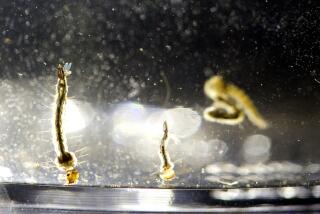Moving a step closer to creating life
- Share via
Using off-the-shelf chemical compounds, scientists for the first time have constructed the entire genome of a bacterium, a key step toward their ultimate goal of creating synthetic life forms, researchers reported today.
The man-made DNA was nearly identical to the natural version on which it was based -- with minor modifications to identify it and render it harmless to people, according to the study in the journal Science.
The research team at the J. Craig Venter Institute in Rockville, Md., is now trying to insert the artificial DNA inside a living cell with the hope that it will take over its host and become the first synthetically created, self-replicating organism.
“This entire process started with four bottles of chemicals,” said J. Craig Venter, who has been spearheading the overall project.
Scientists have previously pieced together individual genes and even whole viruses in the lab, but those were not independent life forms. The genome in this study -- from the bacterium Mycoplasma genitalium -- is more than 10 times larger than any previously synthesized.
Researchers in the nascent field of synthetic biology hope to use the method as a blueprint for designing microscopic creatures that can produce renewable fuels, medicines and industrial products.
“It’s a cookbook for how to make big things,” said Andrew Ellington, a biochemist at the University of Texas at Austin, who was not connected with the study.
Venter, the maverick scientist best known for challenging the federal government’s effort to decode the human genome, has been studying M. genitalium for more than a decade.
With only 485 protein-coding genes and very little extraneous DNA, its genome is smaller than that of any other free-living organism.
Venter wants to make it even smaller and find out just how many genes are required to create “a minimal operating system for life.”
About 100 of the genes can be removed individually without affecting the bacteria’s ability to survive. But that doesn’t mean all 100 genes can be deleted simultaneously. To determine how many are superfluous, he plans to make thousands of versions of the bacterium and see which ones can survive.
An organism’s genome is made up of varying pairs of four chemicals -- adenine, thymine, cytosine and guanine. These base pairs form the rungs in the spiraling double helix of DNA.
Replicating M. genitalium’s entire string of A’s, Ts, Cs and Gs in the lab was the first step in Venter’s plan.
Nature’s version of the bacterium, which causes nongonococcal urethritis and other genital diseases, contains a single circular chromosome that is 580,076 base pairs long.
The research team started out with 101 small fragments of the genome, which were made by three commercial firms that specialize in synthesizing genes and other short DNA sequences.
Each fragment overlapped slightly with the ones on either side.
Then they assembled them into progressively larger chunks.
Four adjoining fragments were combined with an enzyme, which chewed off one strand of DNA at each end. DNA strands naturally pair up, and the overlapping fragments came together spontaneously, said Dr. Hamilton O. Smith, the Nobel Prize-winning biologist who led the team.
The resulting 25 larger pieces were injected into the bacterium Escherichia coli, which made thousands of copies as it divided. The copies were harvested and used in the next stage of the experiment.
The researchers used the same method to combine the 25 pieces into eight larger sections and then paired those up into four bigger segments before they maxed out the capacity of E. coli.
That prompted a switch to a yeast called Saccharomyces cerevisiae, which has a natural tendency to repair broken chromosomes. With the yeast, they were able to combine the four segments into two half-genomes. They made copies and then spliced together the two halves into a complete genome, Smith said.
Along the way, they added five short watermarks to differentiate between the original genome and the copy.
They also modified one of the genes to disable the bacteria’s ability to stick to mammalian cells and cause diseases. The final version of the synthetic genome was 582,970 base pairs long. If printed out on paper in 10-point font, the genome would fill 147 pages.
“Reconstructing a natural bacterial genome from scratch is a great technical feat,” said Drew Endy, a biological engineer at MIT, who wasn’t involved in the study.
The next step for the researchers is to transplant the artificial DNA into a host bacterium and see if it will take over the cell.
Another team at the Venter Institute demonstrated last year that it could convert one species of Mycoplasma into another by replacing all of its DNA. But the species that served as a host in that experiment may not be the best for the synthetic genome, Smith said.
“It’s not just a slam-dunk, or we would be announcing it today,” Venter said. “But we’re confident that they can be overcome, and it’s a matter of time before we have it booted up in a cell.”
With DNA synthesis technology doubling in power every 12 to 18 months, scientists should be able to create customized bacteria by 2012, Endy said.
“Getting better at building DNA . . . is incredibly important,” he said.
The study was funded by Synthetic Genomics Inc. of Rockville, a privately held sister company to the Venter Institute that is designing cells that can produce clean energy.
A green jet fuel is currently being tested, and hundreds of other products could follow, Venter said.
But M. genitalium probably won’t serve as the foundation for those future designer organisms because it is too difficult to grow in the lab, Smith said.
--







